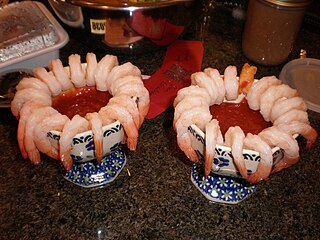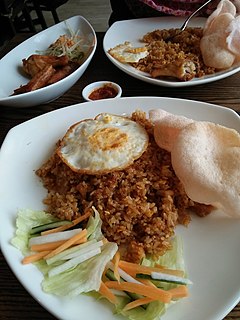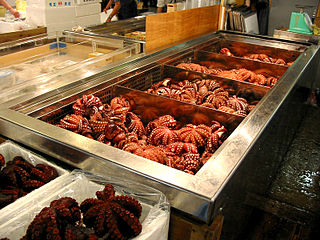Related Research Articles

A mirepoix is a flavor base made from diced vegetables cooked—usually with butter, oil, or other fat—for a long time on low heat without coloring or browning, as further cooking, often with the addition of tomato purée, creates a darkened brown mixture called pinçage. It is not sautéed or otherwise hard-cooked, because the intention is to sweeten the ingredients rather than caramelize them. It is a long-standing cooking technique in French cuisine.

Chow mein is a dish of Chinese stir-fried noodles with vegetables and sometimes meat or tofu. Over the centuries, variations of Chaomian were developed in many regions in China; there are several methods of frying the noodles and a range of toppings can be used. It was introduced in other countries by Chinese immigrants. The dish is popular throughout the Chinese diaspora and appears on the menus of most Chinese restaurants abroad. It is particularly popular in India, Nepal, the UK, and the US.

Rémoulade is a European cold sauce based on mayonnaise. Although similar to tartar sauce, it is often more yellowish, sometimes flavored with curry, and sometimes contains chopped pickles or piccalilli. It can also contain horseradish, paprika, anchovies, capers and a host of other items.
Sweet and sour is a generic term that encompasses many styles of sauce, cuisine and cooking methods. It is commonly used in East Asia and Southeast Asia, and has been used in England since the Middle Ages. Sweet and sour remains popular in Europe and the Americas.

Hokkien mee is a Southeast Asian dish that has its origins in the cuisine of China's Fujian (Hokkien) province. There are three distinct types of Hokkien mee found in Malaysia and Singapore.

Otak-otak is a Southeast Asian fish cake made of ground fish mixed with spices and wrapped in leaf parcels. Otak-otak is traditionally served steamed or grilled, encased within the leaf parcel it is cooked in, and can be eaten solely as a snack or with steamed rice as part of a meal.

Cocktail sauce, also known as seafood sauce, is one of several types of cold or room temperature sauces often served as part of a dish referred to as a seafood cocktail or as a condiment with other seafoods. The sauce, and the dish for which it is named, are often credited to British celebrity chef Fanny Cradock, but seafood cocktails predate her 1967 recipe by some years.

Prawn cocktail, also known as shrimp cocktail, is a seafood dish consisting of shelled, cooked prawns in a Marie Rose sauce or cocktail sauce, served in a glass. It was the most popular hors d'œuvre in Great Britain, as well as in the United States, from the 1960s to the late 1980s. According to the English food writer Nigel Slater, the prawn cocktail "has spent most of see-sawing from the height of fashion to the laughably passé" and is now often served with a degree of irony.

Nasi goreng is a Southeast Asian fried rice dish, usually cooked with pieces of meat and vegetables. One of Indonesia's national dishes, it is also endemic in Malay-speaking communities in countries such as Malaysia, Singapore and Brunei, and has gained popularity in Sri Lanka through migrations from the Malay Archipelago, in countries like Suriname via Indonesian immigrant communities, and in the Netherlands through its colonial ties with Indonesia. Nasi goreng is distinguished from other Asian fried rice preparations by its distinct smoky aroma, and caramelised yet savoury undertones of flavour. There is no single defined recipe for nasi goreng, and its composition and preparation varies greatly from household to household.

A soy egg is a type of egg in Chinese cuisine, Japanese cuisine, and Mauritian cuisine which is boiled, peeled, and then cooked in a mixture of soy sauce, sugar, water, and other optional herbs and spices. Other ingredients such as meat, vegetables and tofu can be cooked in the same red cooking method, resulting in dishes generally referred to as lou mei. Soy eggs can be made from chicken, duck, and quail eggs.

Shrimp creole is a dish of Louisiana Creole origin, consisting of cooked shrimp in a mixture of whole or diced tomatoes, the “holy trinity” of onion, celery and bell pepper, spiced with hot pepper sauce or cayenne-based seasoning, and served over steamed or boiled white rice. The shrimp may be cooked in the mixture or cooked separately and added at the end. Other "creole" dishes may be made by substituting some other meat or seafood for the shrimp, or omitting the meat entirely.

Marie Rose sauce is a British condiment often made from a blend of tomatoes, mayonnaise, Worcestershire sauce, lemon juice and black pepper. A simpler version can be made by merely mixing tomato ketchup with mayonnaise. The sauce was popularised in the 1960s by Fanny Cradock, a British celebrity chef.

Camaron rebosado is a deep-fried battered shrimp dish in Philippine cuisine. It is usually served with a sweet and sour sauce. It is a common dish in Philippine cuisine.

The cuisine of Mauritius is influenced by the tropical location of the island as well as the cultural diversity which characterizes the country. Mauritian cuisine is a blend of African, Chinese, European and Indian influences in the history of Mauritius. Most of the dishes and practices into the culinary traditions are inspired by French culture, former African slaves, and Indian workers and Chinese migrants arriving during the 19th century. Over the years, communities found in Mauritius have adapted and mixed each other's cuisine to their liking, resulting in the development of Mauritian cuisine. While some popular dishes and desserts are consumed by Mauritians of all ethnic groups or communities, there are also form of cuisines which remain distinctly ethnic and are unique to a specific ethnic community due to their ancestral cultural and historical connections. Local food which varies depending on ethnic communities therefore reflects the strong traditional, cultural, and historical influences of each community.

The cuisine of New Orleans encompasses common dishes and foods in New Orleans, Louisiana. It is perhaps the most distinctively recognized regional cuisine in the United States. Some of the dishes originated in New Orleans, while others are common and popular in the city and surrounding areas, such as the Mississippi River Delta and southern Louisiana. The cuisine of New Orleans is heavily influenced by Creole cuisine, Cajun cuisine, and soul food. Seafood also plays a prominent part in the cuisine. Dishes invented in New Orleans include po' boy and muffuletta sandwiches, oysters Rockefeller and oysters Bienville, pompano en papillote, and bananas Foster, among others.

People of some cultures eat octopus. The arms and sometimes other body parts are prepared in various ways, often varying by species and/or geography.
Shelina Permalloo is an English cook, author and winner of BBC's MasterChef in 2012.

Ginataang hipon is a Filipino seafood soup made from shrimp in coconut milk and spices. It differs from other types of ginataan, in that it does not use vegetables. It is a type of ginataan. Variants of the dish includes ginataang curacha and ginataang sugpo, which use spanner crabs and prawn in place of shrimp, respectively.
Curacha Alavar, sometimes referred to as curacha con salsa Alavar in Chavacano a Spanish-based creole language, is a Filipino dish made from spanner crabs (curacha), garlic, ginger, salt, and Alavar sauce. The key ingredient is the Alavar sauce, a secret blend of coconut milk, taba ng talangka, and various spices.

Curry, a spicy Asian-derived dish, is a popular meal in the United Kingdom. Curry recipes have been printed in Britain since 1747, when Hannah Glasse gave a recipe for a chicken curry. In the 19th century, many more recipes appeared in the popular cookery books of the time. Curries in Britain are widely described using Indian terms, such as korma for a mild sauce with almond and coconut, Madras for a hot, slightly sour sauce, and pasanda for a mild sauce with cream and coconut milk. One type of curry, chicken tikka masala, was created in Britain, and has become widespread enough to be described as the national dish.
References
- ↑ "Mauritian recipe: prawn rougaille". Getaway. 27 September 2012. Retrieved 6 October 2018.
- ↑ Permalloo, Shelina. "King Prawn Rougaille (Spicy Creole Sauce) Recipes". Shelina Cooks. Retrieved 6 October 2018.
